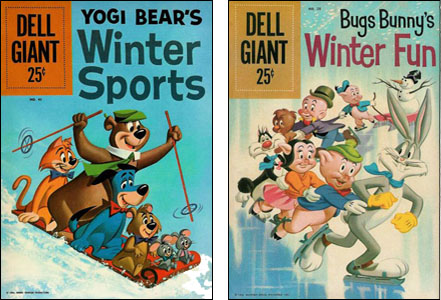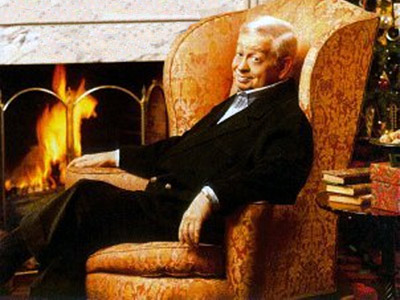From 1953: Gayla Peevey sings her hit record, "I Want a Hippopotamus for Christmas." Every holiday season, I run into at least one situation where a band of young carolers — usually four of them in Victorian garb — are taking requests and performing what's requested…just like in my Mel Tormé story. I always ask for this song, they always know it, they always enjoy singing it — and everyone around enjoys hearing it…
Monday Morning
Based on tests and consultation with my doctor, I'm declaring myself COVID-free. That doesn't mean I won't get it; just that I didn't get it as a result of my brief exposure recently. I'm masking in all public places.
As some of you have noticed, I removed from this blog the widget (that's what you call the little links in the right-hand margin) that invited you to follow me on Twitter. As of this moment, I still have my account but given how volatile and transitory "the rules" are there, I may be making a quick exit any second. It's kind of fascinating how unprepared Elon Musk seems to have been to run it. You'd think a guy shelling out 80 skillion bucks — or whatever he paid for it — would have some sort of plan for it before purchase. That's apart from "Fire half the staff." But no…he seems to be making it up as he goes along.
Because someone e-mails every day or so to ask this: At the moment, I only have two comic conventions on my calendar for 2023: WonderCon in Anaheim in March and Comic-Con in San Diego in July. Pandemic permitting, I'll be at both and Sergio Aragonés may be present as well. Maybe. I may or may not even leave my state next year…something I haven't done since June of 2019.

Lastly for now: Twice a day, I post on my Instagram feed the cover of a comic book I remember owning and loving back in the days when I was small and cute and most comics were a dime or twelve cents. Once in a while, you paid a whopping quarter for a "special" and thicker issue. From now through Christmas, I'm posting covers that relate to Christmas or at least Winter. Above are today's selections. I would post a Hanukkah comic from that period but even though the industry was founded mainly by Jews, there were no such comics.
Today's Sixth Video Link
Here's TCM's annual "TCM Remembers" video featuring some of the folks involved in films who left us this past year…
Today's Fifth Video Link
A message from John Oliver, who's on hiatus until February — and probably kicking himself that he's not on to report on the Trump NFTs…
Hanukkah in Santa Monica – Night 1
And since I'm posting a Christmas video every night leading up to Christmas, I think it's only fair to post a Hanukkah video every night of Hanukkah…so prepare yourself for eight different renditions of the most popular Hanukkah song — that Public Domain Classic, Tom Lehrer's "I'm Spending Hanukkah in Santa Monica." We start with Mr. Lehrer's own recording of it…
And I'll also throw in my new favorite Hanukkah song which is not public domain. In fact, I don't know if they even got permission to parody the hit song on which it's based. This is the Jewish a cappella group known as The Maccabeats…
Interested in a latke recipe? I'll give you a choice. Here is Alton Brown's, which unlike all others I've ever seen doesn't use flour or matzo meal but instead calls for instant mashed potatoes. What would an Alton Brown recipe be without at least one ingredient or kitchen tool that no other human being ever thought of using before?
My mother's latkes — which of course were the best in the world — were made using a slight variation on Jenny Grossinger's recipe. Ms. Grossinger was to Jewish cooking what Antonius Stradivarius was to making violins. Here is that recipe and remember that the most important thing is to make sure you get as much water as possible out before you put them into the frying pan. Mr. Stradivarius did the same thing with his fiddles.
Mark's Christmas Video Countdown – #8
"Santa Baby" sung by Eartha Kitt. Wasn't she wonderful?
My Xmas Story
This is the most popular thing I've ever posted on this weblog. In fact, it's so popular that proprietors of other sites have thought nothing of just copying the whole thing and posting it on their pages, often with no mention of me and with the implication that they are the "I" in this tale. Please don't do that — to me or anyone. By all means, post a link to it but don't just appropriate it and especially don't let people think it's your work. This is the season for giving, not taking.
Yes, it's true…and I was very happy to learn from two of Mel Tormé's kids that their father had happily told them of the incident. Hearing that was my present…
![]()

I want to tell you a story…
The scene is Farmers Market — the famed tourist mecca of Los Angeles. It's located but yards from the facility they call, "CBS Television City in Hollywood"…which, of course, is not in Hollywood but at least is very close.
Farmers Market is a quaint collection of bungalow stores, produce stalls and little stands where one can buy darn near anything edible one wishes to devour. You buy your pizza slice or sandwich or Chinese food or whatever at one of umpteen counters, then carry it on a tray to an open-air table for consumption.
During the Summer or on weekends, the place is full of families and tourists and Japanese tour groups. But this was a winter weekday, not long before Christmas, and the crowd was mostly older folks, dawdling over coffee and danish. For most of them, it's a good place to get a donut or a taco, to sit and read the paper.
For me, it's a good place to get out of the house and grab something to eat. I arrived, headed for my favorite barbecue stand and, en route, noticed that Mel Tormé was seated at one of the tables.
Mel Tormé. My favorite singer. Just sitting there, sipping a cup of coffee, munching on an English Muffin, reading The New York Times. Mel Tormé.
I had never met Mel Tormé. Alas, I still haven't and now I never will. He looked like he was engrossed in the paper that day so I didn't stop and say, "Excuse me, I just wanted to tell you how much I've enjoyed all your records." I wish I had.

Instead, I continued over to the BBQ place, got myself a chicken sandwich and settled down at a table to consume it. I was about halfway through when four Christmas carolers strolled by, singing "Let It Snow," a cappella.
They were young adults with strong, fine voices and they were all clad in splendid Victorian garb. The Market had hired them (I assume) to stroll about and sing for the diners — a little touch of the holidays.
"Let It Snow" concluded not far from me to polite applause from all within earshot. I waved the leader of the chorale over and directed his attention to Mr. Tormé, seated about twenty yards from me.
"That's Mel Tormé down there. Do you know who he is?"
The singer was about 25 so it didn't horrify me that he said, "No."
I asked, "Do you know 'The Christmas Song?'"
Again, a "No."
I said, "That's the one that starts, 'Chestnuts roasting on an open fire…'"
"Oh, yes," the caroler chirped. "Is that what it's called? 'The Christmas Song?'"
"That's the name," I explained. "And that man wrote it." The singer thanked me, returned to his group for a brief huddle…and then they strolled down towards Mel Tormé. I ditched the rest of my sandwich and followed, a few steps behind. As they reached their quarry, they began singing, "Chestnuts roasting on an open fire…" directly to him.
A big smile formed on Mel Tormé's face — and it wasn't the only one around. Most of those sitting at nearby tables knew who he was and many seemed aware of the significance of singing that song to him. For those who didn't, there was a sudden flurry of whispers: "That's Mel Tormé…he wrote that…"
As the choir reached the last chorus or two of the song, Mel got to his feet and made a little gesture that meant, "Let me sing one chorus solo." The carolers — all still apparently unaware they were in the presence of one of the world's great singers — looked a bit uncomfortable. I'd bet at least a couple were thinking, "Oh, no…the little fat guy wants to sing."
But they stopped and the little fat guy started to sing…and, of course, out came this beautiful, melodic, perfectly-on-pitch voice. The look on the face of the singer I'd briefed was amazed at first…then properly impressed.
On Mr. Tormé's signal, they all joined in on the final lines: "Although it's been said, many times, many ways…Merry Christmas to you…" Big smiles all around.
And not just from them. I looked and at all the tables surrounding the impromptu performance, I saw huge grins of delight…which segued, as the song ended, into a huge burst of applause. The whole tune only lasted about two minutes but I doubt anyone who was there will ever forget it.
I have witnessed a number of thrilling "show business" moments — those incidents, far and few between, where all the little hairs on your epidermis snap to attention and tingle with joy. Usually, these occur on a screen or stage. I hadn't expected to experience one next to a falafel stand — but I did.
Tormé thanked the harmonizers for the serenade and one of the women said, "You really wrote that?"
He nodded. "A wonderful songwriter named Bob Wells and I wrote that…and, get this — we did it on the hottest day of the year in July. It was a way to cool down."
Then the gent I'd briefed said, "You know, you're not a bad singer." He actually said that to Mel Tormé.
Mel chuckled. He realized that these four young folks hadn't the velvet-foggiest notion who he was, above and beyond the fact that he'd worked on that classic carol. "Well," he said. "I've actually made a few records in my day…"
"Really?" the other man asked. "How many?"
Tormé smiled and said, "Ninety."
I probably own about half of them on vinyl and/or CD. For some reason, they sound better on vinyl. (My favorite was the album he made with Buddy Rich. Go ahead. Find me a better parlay of singer and drummer. I'll wait.)
Today, as I'm reading obits, I'm reminded of that moment. And I'm impressed to remember that Mel Tormé was also an accomplished author and actor. Mostly though, I'm recalling that pre-Christmas afternoon.
I love people who do something so well that you can't conceive of it being done better. Doesn't even have to be something important: Singing, dancing, plate-spinning, mooning your neighbor's cat, whatever. There is a certain beauty to doing almost anything to perfection.
No recording exists of that chorus that Mel Tormé sang for the other diners at Farmers Market but if you never believe another word I write, trust me on this. It was perfect. Absolutely perfect.
Additional Information
Back in this post, I remembered an episode of Virginia Graham's old talk show in early 1971 on which Carmine Infantino appeared. This was back when Carmine was the top guy at DC Comics and he was on to discuss the new books DC was putting out. I wrote, "I may be remembering another show Carmine did but my recollection is that Telly Savalas was a guest on the same episode and that he started lambasting Infantino for selling comic books full of violence to children."

Well! Bill Mullins, a faithful reader of this site who has dug up additional info on many things I've written about, dug into the archives of the Los Angeles Times and he found a listing for that program. It was on at 8:00 in the evening — at least it was in Los Angeles — and Telly Savalas was indeed a guest as were Joanna Barnes and Ron Eliran. In case you don't recognize the name, Ron Eliran is a great singer of Israeli folk songs. The date is April 14, 1971.
It's doubtful a tape of that episode will ever turn up and based on my memory, that's not a great loss. Mr. Infantino was a brilliantly talented artist but he was not a great spokesperson for his product, especially compared to Stan Lee. Carmine came across not as a friendly, creative person but like a guy in a gangster movie. A few years later, called upon to defend his company's treatment of Jerry Siegel and Joe Shuster, he gave off precisely the wrong image. Matter of fact, he sounded like Telly Savalas in one of the many movies in which Savalas played the bad guy.
Happy Blog Birthday!

Thank you for visiting this page whenever you have visited this page. And that's about all I have to say about it except that, as always, donations are appreciated. Keeping this blog up and running is costing more and more…like everything else in this world. And besides, I blew all my savings on Donald Trump NFTs.
Mark's Christmas Video Countdown – #9
I came across this recently on the Internet and I really liked it. It's Josh Turner and his guitar and band accompanying two fine vocalists called The Ladybugs…
Free Lehrer
More than a dozen of you have written me lately to tell me that the great writer-performer of funny songs, Tom Lehrer, has announced that he's putting his works into the public domain. Anyone is free to do anything with the songs he wrote. They don't need permission. They don't need to pay him. And on his website, it's possible to download audio files of just about anything he ever recorded and in many cases, the sheet music as well.
Thank you all for writing to tell me about this but it's not news. I covered it back here more than two years ago. But I figured if so many people are writing to tell me about it, maybe I oughta mention it again.
Tater Trick
I recently solved two tiny problems in my kitchen. You probably never had either of these problems or if you did, you figured out how to solve them in a lot less time than it took me. But just in case anyone reading this can benefit from my silly little discovery, here goes…

I love baked potatoes, especially when they taste like baked potatoes. It is sometimes a struggle in restaurants to stop service people from drowning mine in sour cream, salsa, black beans, chili, buffalo sauce and all sorts of other toppings including eleven different kinds of cheese. I just want butter and a little salt on mine…or sometimes, in lieu of the butter, ketchup but not a lot of it.
Well, even I could figure out the solution to that: Bake your own potatoes at home, which I tried doing. But that gave me the two tiny problems I've solved…
First tiny problem: I don't want to turn on the oven for one potato, especially given how long it takes to bake one that way. So what's the alternative? The microwave, of course…
…but for some reason, neither my current microwave oven nor the one I had before it could do a decent job of baking a potato. The spuds came out flat and overcooked on the bottom even when I dutifully rotated them in mid-bake. Then I tried a few commercial products, like one where you insert the tater into a little cloth bag before microwaving. That time, the potato was overdone in places, underdone in others and the bag was charred like it had caught fire for part of the cooking time.

Solution to this tiny problem: I tried one of these and while it is overpriced considering how cheap one must be to make, it did work. In fact, it worked as advertised, even though it's advertised on television. I'm not suggesting it will work for you but it worked for me and I also use it to heat up corn-on-the-cob.
Second tiny problem: I don't like potato skins, especially Russet potato skins, and my stomach doesn't like them. But it's annoying to scoop the filling out of a baked potato, especially when that temperature of that potato is 27 million degrees Fahrenheit (15 million degrees Celsius). Also, you wind up not getting a large percentage of the inside of the baked potato.
Solution to this tiny problem: I bought a potato ricer. Again, I'm not suggesting this one's better than any other model because this was the only one I've tried…but it works pretty well for my purposes.

So I scrub the potato, put it in the Yummy Can Potatoes Microwave Potato Cooker and put the whole thing in my microwave and run it on full power for six minutes. Then I let it sit for 5-10 more to finish baking and to cool down enough for handling. (One problem with the Yummy Can: It doesn't accommodate the really large Russets.)
When the potato is touchable but still warm, I cut it in half and then put one half, cut side down, into the potato ricer and squeeze the bejeesus out of it. It extrudes all the delicious white interior but leaves the skin inside. You lose very little of the interior. Then I remove the skin from the chamber and process the other half of the potato. You will need a knife to scrape off the extruded innards.
The result? A dish of lovely, skinless baked potato…and you'll be surprised how much more you get out of one that way. I add salt and butter, mix it all up and it's exactly what I want. The ricer is handy for other things like making mashed potatoes or juicing lemons. What a neat tool to have in a kitchen.
Yes, I know that getting cooking advice from me is a lot like getting medical advice from a raccoon but occasionally, I stumble across something that works. And during The Pandemic, it feels like a lot of people have gotten their medical advice from raccoons.
Dispatches From the Fortress – Day 1010

This morning's COVID test was negative. If the next one a few days from now is likewise, I shall emerge once again from the fortress and declare myself fit to mingle with others, albeit masked. Just doing what my doctor recommends.
You get the feeling that Trump's current presidential campaign is about (a) seeing how much money he can wring out of his supporters, (b) being able to argue that all prosecutions of him and his family are politically-motivated and therefore bogus, and (c) nothing else? He never really cared about most of the things his supporters care about but now he's not even pretending.
The first issue of the new four-issue Groo mini-series comes out next Wednesday. It's called Gods Against Groo and it's of a piece with two earlier Groo mini-serieses (I've decided that's the plural of "series") we've done in the past. As always, it's drawn by Sergio Aragonés, he and I collaborated on the story and Stan Sakai lettered it. As is fairly new, Carrie Strachan did the coloring and while we were not happy to lose the services of Tom Luth — aka The Hardest-Working Person in Comics — we were fortunate to find Carrie.
I have about fifty yet-to-be-answered questions in my "ASK me" folder — questions you folks have sent in for me to address on this blog. More than forty of them are about comic books so if you have no interest in comics and want to see me write about TV or movies or stand-up comedy or the campaign to criminalize cole slaw, you probably should send in an appropriate question to this address. Thank you.
Today's Non-Holiday Video Link
Well, it has a little to do with Christmas. Devin "Legal Eagle" Stone fills us in about some toys that caused their makers to wind up in court…
Mark's Christmas Video Countdown – #10
Over the next ten days, I'm going to link to my current ten favorite Christmas videos, one a day. Here's the first one…
Some years ago, back before he was on CBS, Stephen Colbert did a tune and video called "Another Christmas Song," which was written by David Javerbaum and Adam Schlesinger. I thought it was clever and funny and just great but his video of it doesn't seem to be online anywhere, at least in a linkable form. You can listen to the song though on this video…